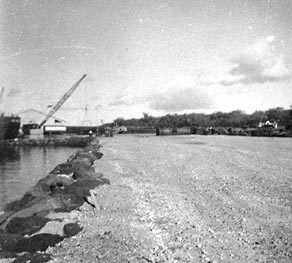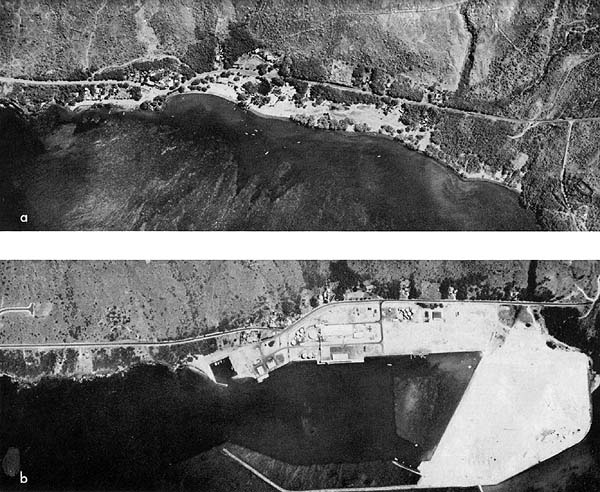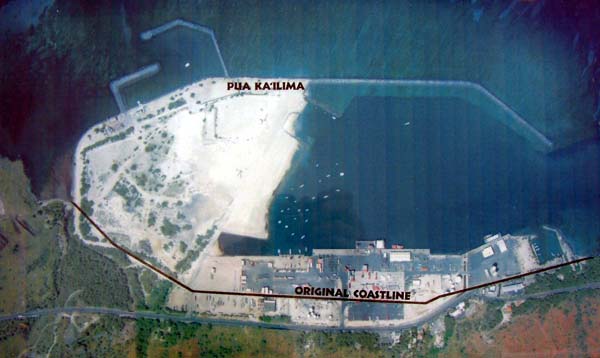 |
 |
 |
|||||
|
|
|||||||
|
|
|||||||
| |
|
|
|
“In the ‘50s is when they did the Harbor,” Papa Akau says. “Well, this one out here was destroyed when ’46 tidal wave came, so right off they built a barge terminal first. That was in ’46. Then early ’50 they started the deep-sea harbor. It was in the ‘50s. I wasn’t home when they did the Harbor, I was in Japan.”
|
||
|
|
||
“Unfortunately, they needed a more centralized harbor,” Jeannine explains, “because there was one in Kona, the other one was in Hilo, which were very, very, very far away. And they needed a harbor for the boats to come in, I guess they call it ‘progress.’ But Kawaihae didn’t have a harbor. It had the natural curvature of the coastline, but there was really no harbor. So they brought in the dredging company.” “Pacific Dredge,” Pua clarifies. “My husband Louie worked in the coral flats. Oh, do I remember all that. And when they started to bring the things in, I still remember that day so very clearly, when they started to bring all the equipment in, we were very, very against them developing Kawaihae.”
|
|
|
“For I don’t know how long, maybe months and months and months, they had these big drilling machines,” Jeannine recalls, “with the big thing that shoots out all of the sand as they are digging the ocean. And with that was a lot of the shells. But after that, the beach was no more.” “It was all sand,” ‘Ilima adds, “and then they started dredging the coral, and as they dredged the coral they began to shoot it out. That’s where you have coral flats now. That’s all coral that was there in Kawaihae. "And for the local people, it was a sad time. But progress came, and people demanded more things, and so then after a while there was nothing that really looked like Kawaihae. Except maybe when you go to Spencer Park and just along the shore.”
|
| |
|
|
“What they did when they dug the harbor," Lala explains, "they pumped the material all here, all the way down they pumped…You see that coral flats? It wasn’t there. They pumped the coral right inside the coral flats there. We dredged it, went down 50 feet’s worth. I was a young boy. “We had a lot of bait here at that time, before we had the harbor. When they dredged the place out, no bait. Hardly any bait at all. Because I guess from the mud from the heiau, that drew the nehu in. Used to have a lot of tuna out there. There were thousands of them, just thousands, schools all over the place. Now you can hardly even find one school out there! Even Honolulu gave up the tuna boats, the 90 footers, the 100 footers. They get the old small boat harbor down there. They built it, but we can’t use it. They haven’t finished it—about 20 years now. It’s still there. “Where we used to live, the tidal wave had washed it away. Everybody moved further back. All the village was around the Davis tomb. Then the State took over. They exchanged lands. Used to be Hawaiian Homes.”
|
||
|
|
||
“Their houses were taken, they were demolished,” ‘Ilima says. “People owned their own land. And of course then there were a lot of them that were just ‘squatters’—they were allowed to make just a lean-to and live there. But the people that were living there, I guess they were offered good money, so they could sell and move away and build another home. "It was the older ones that just kind of lived there until they died. For the younger generation, it was no longer Kawaihae, and so they kind of moved up to Waimea, and some of them moved here to Kohala, and then some just moved away." “What can they do?” Lani asks. “There
is nothing they can do. That’s what the government wants to do,
they have to do it. There was nothing we could do about it. A lot of
the Hawaiians got upset, but what can they do? Nothing.”
|
|
|
“Where I grew up, that was my Dad’s property,” Pua recalls. “When they told us that we needed to get out of there because they were going to develop there, my Dad said ‘No.’ And the Corps of Engineers said that because they have to develop there, we have to move. And my Dad said, ‘No.’ He said ‘For every bulldozer that you bring to take me down, I’ll shoot everyone of your drivers that comes try to destroy my family and me.’ He told that to the chief of the engineers, because they were coming in with the bulldozer. “But they condemned our property. And once they condemn that property, we have to get out. So we had to go look for the Hawaiian Homes give us a piece of property. And that’s why we’re here today. At that time my parents didn’t have money and they were not educated. And we were young, we didn’t know what the heck was going on. So we had to scramble to move. "But my Dad had a good, good friend with the Corps of Engineers. Sunagnini was his last name; he was the top man for the Corps of Engineers. So they had to move our old house with us. The Corps of Engineers did that. And we lived here in that house, on 55-gallon drums that they set it on.”
|
| |
|
|
| “They pushed people out,” Papa remarks. “They had no place to go. Lucky we were above here, so no trouble like the ones below. They promised they were going to make some kind of change where they can put them on the land. But with a lot of people, they paid for the land and gave them the money, that was it. Just like Mel them, because the land went to the Mother, I think. And then went to the Uncle, and so they got nothing.” “The pier down there saved them transporting millions of dollars in transporting the sugar to Hilo,” Mel concludes. “But there was suffering on the other side. The land owners did not get just compensation for their property. My Grandfather’s property in Kawaihae was given to me by his word to my Mother. At his death my Mother asked me to give the property to her younger brother, William, which I did. I was offered a car in the process, and at that time a car was more appealing to a 16 year old boy."
|
||
|
|
||
“But I always was concerned about that place, so when I came back from Mainland and I went back over there, the first time I got back over there, the Kawaihae I knew—my grandfather’s place—was wiped out from the harbor coming in. They had condemned the place for public purposes. And I really wanted to know what my uncle had done, whether he had sold the place, and if he did…. "Years later I saw my Uncle William in Hilo and asked him about the property. He was paid only $284 and he still had the check. He was so angry at the small amount the government paid out, that he could never cash that check."
|
|
|
“And my grandfather’s place was an oasis in Kawaihae. He had coconut trees growing. Everything for eat, he planted. Flowers he pulled—only can smell, no can eat. But everything for eat, like breadfruit, coconut...plenty coconut trees. And he always watered his plants, every day. His place was green. A lot of places dry. Plus you have one fish pond behind the house. Get kapu, the fish pond." "The fish pond, oh, they covered it over," Lala adds. "The construction, they covered the pond, covered everything." “The pier down there saved them billions of dollars in transporting the sugar to Hilo," Mel concludes. "And who suffered? The guys who owned the land over there. Yea, so that’s the kind of stuff that drives me to what I’m doing.”
|
|
|
|
"Kawaihae has changed a lot," Ku‘ulei remarks. "Now there’s not too many residential people because they had to move away. The land’s been replaced. My Auntie lives in Hawaiian Homes Land, but these families originally lived on the beach at Kawaihae. Then when the change came and they dredged out the beach and filled it in with the harbor, they condemned the land. So for the Hawaiian people that were living down there, they got Hawaiian Homes to get involved and award these people leased land. "So it’s like an exchange, but it’s not really an exchange because they took the land these people owned, and gave them something that they can’t own. So it wasn’t a good exchange, but at least they got to stay here in Kawaihae where they were from. "But slowly, as the families start dying away, they’re taking back the land and they’re not opening it up to new people. They’re going to change it all into commercial and industrial."
|
||
|
|
||
| This radical transformation of the village and the disperal of its residents to other areas brings us to a consideration of the present and future of Kawaihae. In the next chapter, our guides look onwards.
|
||
|
|
||
|
|
|
|
|
|

|
| Kawaihae Home | Map Library | Site Map | Hawaiian Islands Home | Pacific Worlds Home |
|
|
|
|
|
|
|||
| Copyright 2006 Pacific Worlds & Associates • Usage Policy • Webmaster |
|||













